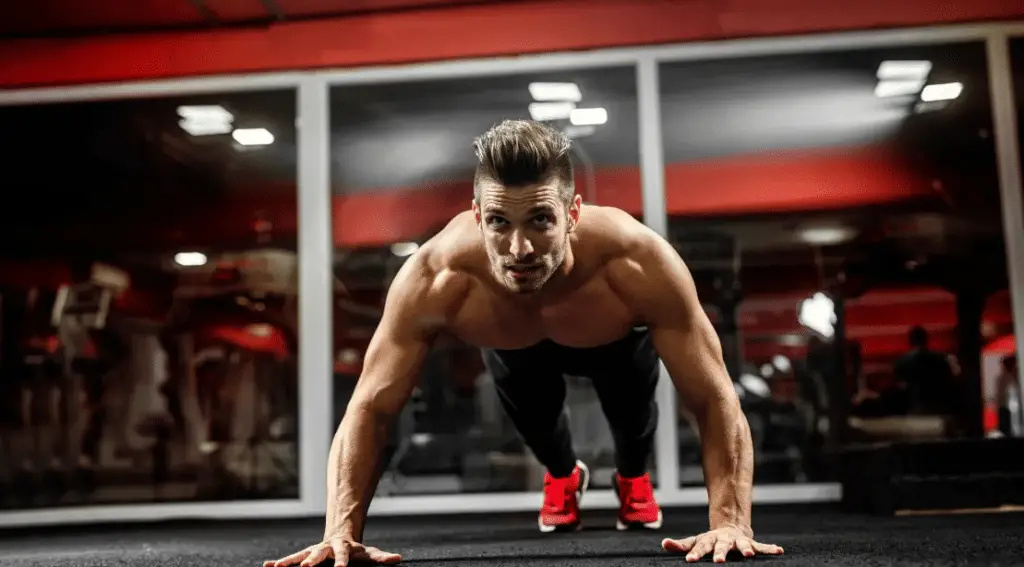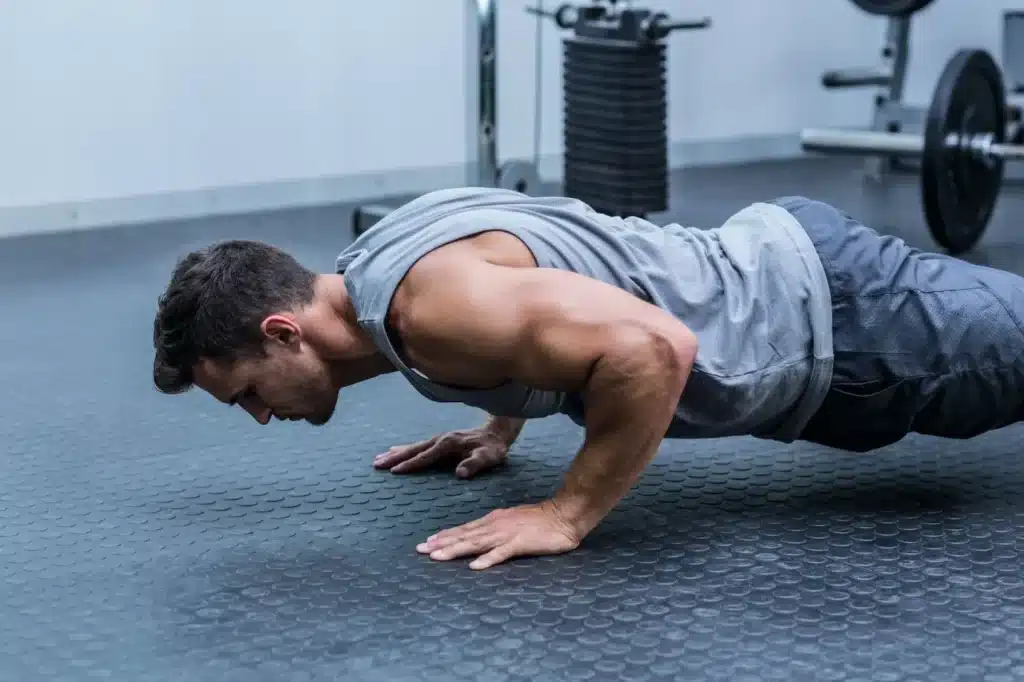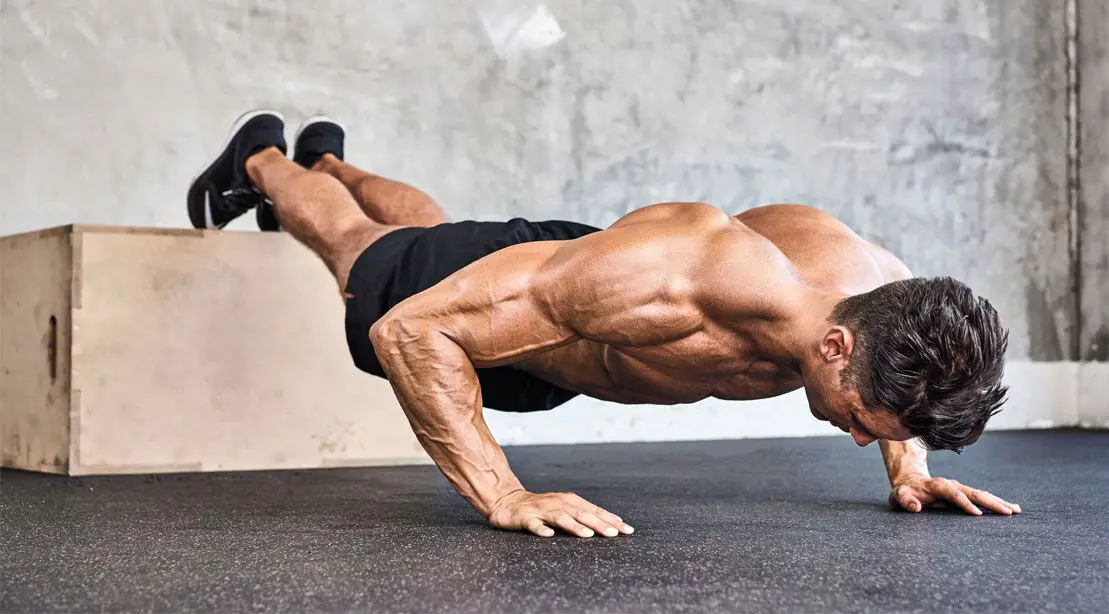Introduction
What Pushups Work Chest: Pushups are a timeless and versatile bodyweight exercise that can be performed virtually anywhere, making them a staple in countless fitness routines. While pushups engage multiple muscle groups in the upper body and core, they are particularly effective at targeting the chest muscles. Whether you’re aiming to strengthen and tone your chest, improve your overall upper body strength, or simply add variety to your workout regimen, pushups offer a practical and efficient way to achieve these goals.
Pushups and their impact on the chest, we’ll delve into the different pushup variations and techniques that specifically emphasize chest development. The mechanics behind these exercises and how they engage the pectoral muscles will enable you to tailor your fitness routine to your desired outcomes. Whether you’re a beginner looking to get started or a seasoned fitness enthusiast seeking to maximize your chest gains, this will provide you with valuable insights into the diverse world of pushups and their impact on chest strength and aesthetics.
The chest, consisting of the pectoralis major and pectoralis minor muscles, is responsible for various movements involving the arms, including pushing and hugging. As such, targeting and working these muscles effectively is a key component of upper body strength training. Pushups, when performed correctly and with the right form, can engage and challenge the chest muscles, making them a fundamental exercise for individuals looking to develop a stronger, more defined chest.

Do push ups work my chest?
While the push-up largely targets the muscles of the chest, the pectoralis major and minor, several other muscle groups contribute. Namely, these include the triceps, anterior deltoids, and the core muscles.
Chest Engagement: The primary function of the pectoralis major is to bring your upper arm across your body. During a push-up, this muscle is activated as you push your body away from the floor.
Triceps Activation: The triceps, located on the back of your upper arm, also play a significant role in extending your elbows during the upward phase of the push-up.
Shoulder Stabilization: The anterior deltoids, the front part of your shoulder muscles, help stabilize the shoulder joint during the exercise.
Core Engagement: Your core muscles, including the abdominals and obliques, engage to maintain a straight body position from head to heels. This is crucial for balance and preventing sagging or arching of the back.
How many push ups are enough for chest?
White defines that as 10 to 20 push-ups if your max is 25 reps, 2 sets of 10 to 20 if your max is between 25 and 50 reps, and 2 to 3 sets of 10 to 20 if your max is above 50 push-ups. “If you’re doing many sets and hitting a high volume, I would try to do them every other day,” he advises.
Fitness Level: Beginners may see significant chest development with just a few sets of push-ups. More advanced individuals, on the other hand, might require higher volumes or additional resistance (like weighted push-ups) to continue progressing.
Goals: Your specific fitness goals play a significant role. If your aim is to increase strength, you may focus on lower-repetition, higher-intensity training. If you’re looking for muscular endurance or general fitness, higher-repetition sets might be more appropriate.
Variation: Incorporating various push-up variations, such as wide-grip, close-grip, incline, or decline push-ups, can help target different areas of the chest and contribute to more balanced chest development.
Progressive Overload: To continually stimulate chest growth, it’s crucial to apply the principle of progressive overload. This means gradually increasing the resistance, intensity, or volume of your push-up workouts over time.
Overall Workout Routine: Chest development is just one component of an overall upper body training program. It’s important to incorporate other chest-specific exercises and balance them with back and shoulder exercises for well-rounded upper body strength.
Recovery and Nutrition: Adequate rest and proper nutrition are essential for muscle growth. Ensure you’re getting enough protein and allowing your muscles time to recover.
Do Hindu pushups work lower chest?
Full-body workout: The Hindu push-up engages multiple muscle groups simultaneously, making it a highly effective compound exercise. It targets the chest, shoulders, arms, back, core, and legs. By working multiple muscles at once, it can enhance overall strength and functional fitness.
Hindu pushups, also known as “dive bomber” push ups, are a compound bodyweight exercise that primarily target the upper body, including the chest, shoulders, and triceps. While they engage the chest muscles to some extent, they are not a specific exercise for isolating or emphasizing the lower chest.
The pectoral muscles (chest) consist of the upper chest (clavicular portion) and lower chest (sternal portion). To emphasize the lower chest, you would typically incorporate exercises that involve a decline or incline motion. Decline push-ups or bench presses with a decline angle are examples of exercises that place more stress on the lower chest.
Hindu pushups involve a flowing, dynamic movement that focuses on stretching and contracting the chest and shoulders. While they provide a comprehensive upper body workout, they are not specifically designed to isolate the lower chest.
Which pushup is best for back?
According to a study in the Journal of Athletic Training , reverse pushups are especially effective at working your abs and back muscles. Experts recommend them for total upper-body strength conditioning.
Wide-Grip Push-Ups: Performing push-ups with your hands placed wider than shoulder-width apart can engage the upper back muscles more than traditional push-ups. The wider hand placement places additional stress on the muscles between and around the shoulder blades.
Diamond Push-Ups: Diamond push-ups involve placing your hands close together beneath your chest, forming a diamond shape with your thumbs and index fingers. While the primary focus remains on the triceps, this variation can also engage the upper back more than standard push-ups.
T Push-Ups: T push-ups combine a traditional push-up with a rotational component. After each push-up, you rotate your torso and raise one arm toward the ceiling. This movement engages the muscles of the upper back as you twist and stabilize.
Which pushup is best for upper chest?
Incline pushups are a great way to target your upper chest muscles. The exercise is performed the same way as a regular pushup, but with your hands elevated on a bench or other raised surface: Get into the starting position with your abs tight and glutes clenched. Place your hands on a bench or other raised surface.
Incline Push-Ups: Incline push-ups involve placing your hands on an elevated surface, such as a bench or a set of parallel bars. This angle places more emphasis on the upper chest. The steeper the incline, the greater the emphasis on the upper chest.
Decline Push-Ups: In contrast to incline push-ups, decline push-ups involve placing your feet on an elevated surface, and your hands remain on the floor. This angle shifts the focus to the upper chest and is achieved by positioning your feet higher than your head.
Wide-Grip Push-Ups: Wide-grip push-ups, where your hands are positioned wider than shoulder-width apart, engage the upper chest more than regular push-ups.
Clap Push-Ups: Clap push-ups involve an explosive push-off the ground followed by a clap in mid-air before returning to the push-up position. These can provide an additional challenge to the upper chest due to the increased force required to lift your body off the ground.
Plyometric Push-Ups: Plyometric push-ups involve an explosive push-off the ground, similar to clap push-ups, but without the clap. The rapid movement engages the upper chest more than regular push-ups.
Will my chest grow if I do 100 pushups a day?
Completing 100 Push Ups a day can lead to increased muscle mass and upper body strength, specifically in the chest, shoulders, triceps, and core. It can also improve endurance and cardiovascular health.
Progressive Overload: To promote muscle growth, you need to gradually increase the resistance or difficulty of your workouts over time. Doing the same number of push-ups daily might maintain your current level of strength and endurance but is less likely to lead to significant muscle growth.
Variation: While push-ups are a great exercise, your body can adapt to a specific exercise over time, and the same stimulus might not continue to challenge your muscles. To stimulate muscle growth, consider incorporating different push-up variations, increasing the intensity, or adding resistance, such as weight vests or resistance bands.
Rest and Recovery: Adequate rest and recovery are essential for muscle growth. If you’re doing 100 push-ups daily without giving your muscles sufficient time to recover, you may not experience optimal growth, and the risk of overuse injuries may increase.
Nutrition: Proper nutrition, including sufficient protein intake, is crucial for muscle growth. Ensure you are consuming enough protein to support muscle repair and growth.
Individual Factors: Muscle growth can vary between individuals based on factors like genetics, age, gender, and hormone levels.
At what age do muscles stop growing?
Typically, muscle mass and strength increase steadily from birth and reach their peak at around 30 to 35 years of age. After that, muscle power and performance decline slowly and linearly at first, and then faster after age 65 for women and 70 for men.
Puberty and Adolescence: During puberty, which typically occurs between ages 9 and 16, there is a significant increase in the production of growth hormone and testosterone, which contribute to muscle development. Muscle growth can be substantial during this period, particularly for boys.
Early Adulthood: Most people continue to experience significant muscle growth and development into their early 20s. This is the time when many individuals build the foundation of their muscle mass.
Ageing: As people move into their late 20s and beyond, the rate of muscle growth tends to slow down. However, muscle growth can still occur well into adulthood, particularly with consistent resistance training and a focus on maintaining overall health and fitness.
Hormonal Changes: Hormonal changes associated with aging, such as a decrease in testosterone and growth hormone levels, can impact muscle growth. However, these changes don’t mean that muscle growth completely stops; it just becomes more challenging.
Lifestyle and Training: Factors like diet, physical activity, and strength training play a significant role in maintaining and promoting muscle growth as you age. Regular strength training and a balanced diet can help slow the loss of muscle mass and may even lead to additional muscle development.
Which pushup works the most muscles?
Though doing a traditional push-up on an incline—with a bench, box, or another elevated surface—makes the move easier, it’s hitting your chest muscles and shoulders more than when you’re doing it flat on the ground.
Chest (Pectoralis Major): The primary muscle engaged during a push-up is the pectoralis major, which is responsible for the pressing motion.
Shoulders (Deltoids): The anterior deltoids, the front part of your shoulder muscles, are involved in stabilizing the shoulder joint.
Triceps (Triceps Brachii): The triceps, located on the back of your upper arm, play a significant role in extending your elbows during the upward phase of the push-up.
Upper Back (Trapezius and Rhomboids): These muscles help stabilize the shoulder blades and prevent your shoulders from rolling forward during the exercise.
Core (Abdominals and Obliques): Your core muscles engage to maintain a straight body position from head to heels. This is crucial for balance and preventing sagging or arching of the back.
Legs (Quadriceps and Hamstrings): Your leg muscles help control your body position and prevent your hips from sagging.

Conclusion
Pushups are a versatile and effective bodyweight exercise that can significantly engage the chest muscles when performed correctly. By varying hand placement and form, you can target different areas of the chest for a well-rounded chest workout. Standard push ups, with your hands positioned slightly wider than shoulder-width apart, emphasize the central chest muscles, while wide-grip pushups focus more on the outer chest. On the other hand, close-grip pushups place greater stress on the triceps but also provide some chest engagement.
These variations, along with incline and decline pushups, offer a comprehensive approach to chest development. The effectiveness of pushups in working the chest depends on your commitment to proper form, consistent training, and progressive overload. Incorporating them into your fitness routine, along with other chest-specific exercises, can help you achieve a well-developed and strong chest.
You’re a beginner or an experienced fitness enthusiast, pushups provide a versatile and accessible means of building chest strength, and with dedication, they can be a valuable component of your chest workout regimen. While pushups are a valuable chest exercise, a well-rounded training program should include a variety of exercises that target the chest from different angles and with different resistance levels. This approach will help you achieve balanced chest development and overall upper body strength.


1 comment
Your article helped me a lot, is there any more related content? Thanks!